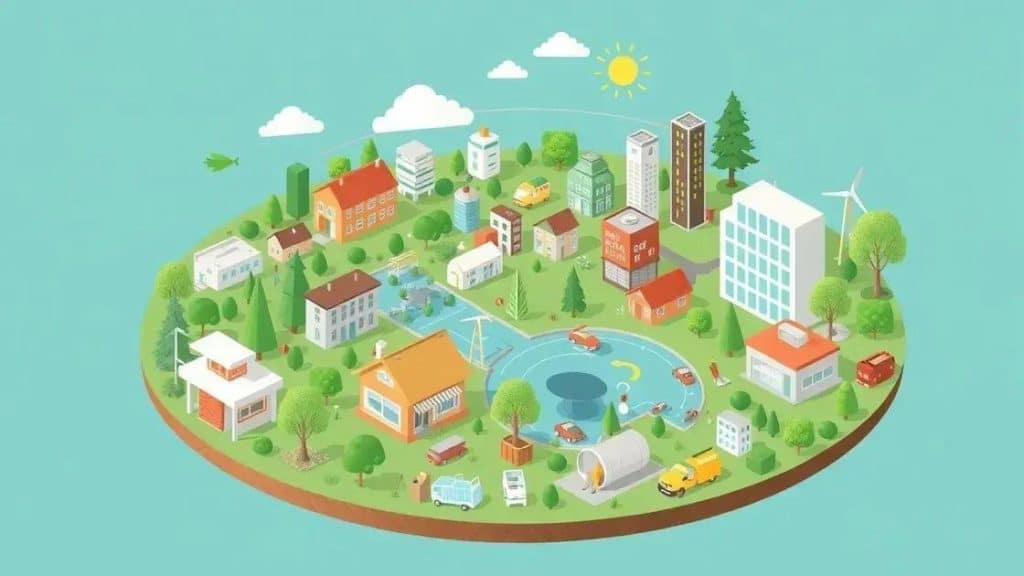Circular economy business strategies transforming industries

Circular economy business strategies focus on sustainability by minimizing waste, promoting resource reuse, and enhancing innovation, ultimately leading to cost savings and a competitive edge in the market.
Circular economy business strategies are reshaping the way companies operate, moving from a linear to a more sustainable model. Have you considered how this shift impacts your industry?
Understanding circular economy fundamentals
Understanding the fundamentals of the circular economy is essential for businesses looking to innovate and embrace sustainability. At its core, this concept focuses on minimizing waste and making the most of resources. By shifting from a traditional linear model—where goods are created, used, and disposed of—businesses can create a system that values reuse and recycling.
Key Principles of Circular Economy
The main principles that define a circular economy include:
- Reducing waste by designing products that last longer and can be repaired.
- Encouraging the reuse of materials and resources to extend their life cycle.
- Utilizing renewable resources to minimize environmental impact.
When businesses adopt these principles, they pave the way for a sustainable future. This approach not only benefits the environment but also leads to cost savings and efficiency improvements. For instance, companies can reduce their dependence on raw materials by using recycled materials, which can lower production costs and meet consumer demand for sustainable products.
The Importance of Sustainable Practices
Implementing circular economy practices helps businesses stay competitive. Customers are increasingly interested in sustainability; they prefer brands that demonstrate environmental responsibility. By communicating a commitment to circular practices, companies can enhance their brand image and attract more consumers. Furthermore, government regulations are beginning to support sustainable initiatives, creating a favorable environment for businesses that adopt these strategies.
In addition to customer preference, integrating circular economy models can lead to innovation. As businesses rethink how they design and deliver their products, they discover new opportunities to engage customers and create value. This innovative spirit fosters a culture of continuous improvement, where companies can thrive in today’s dynamic market.
Benefits of implementing circular economy strategies

Adopting circular economy strategies offers significant benefits for businesses striving to enhance sustainability and efficiency in their operations. These strategies not only minimize waste but also promote innovative practices that can lead to long-term growth and success.
Environmental Impact
One of the most crucial advantages is the positive impact on the environment. By reducing the extraction of finite resources, companies can help preserve ecosystems and decrease pollution. Furthermore, implementing sustainable practices leads to less landfill waste and lower greenhouse gas emissions.
- Reduction of resource depletion.
- Lower carbon emissions through efficient manufacturing.
- Enhanced biodiversity by lessening habitat destruction.
Beyond environmental benefits, there are strong economic incentives for businesses. Transitioning to a circular economy can drive cost savings. Companies can save money by reusing materials and reducing their reliance on costly raw materials. Additionally, optimizing waste management processes leads to lower disposal fees.
Increased Competitiveness
In today’s market, consumers are becoming more eco-conscious. Businesses that embrace sustainable practices make themselves more attractive to a growing demographic of environmentally aware customers. As a result, companies can improve their brand reputation and customer loyalty.
Moreover, adopting circular economy principles fosters innovation. Businesses are encouraged to rethink their product designs, leading to the creation of more efficient and sustainable products. This innovation can open up new markets and revenue streams while enhancing customer satisfaction.
Case studies of successful circular businesses
Exploring case studies of successful circular businesses provides valuable insights into how companies can thrive by adopting circular economy principles. These examples showcase real-world applications, demonstrating the benefits and effectiveness of sustainable strategies.
Notable Examples
One prominent example is Patagonia, the outdoor clothing company known for its environmental activism. Patagonia has implemented a take-back program, encouraging customers to return their used items. This initiative not only reduces waste but also allows the company to recycle materials, creating new products from old ones.
- Patagonia’s Worn Wear program emphasizes durability and reuse.
- Customers receive credit for returned items, promoting a circular cycle.
- Shop products made from recycled materials.
Another inspiring example is Interface, a global carpet tile manufacturer. Interface has committed to becoming a carbon-negative company by 2040. They focus on reducing their carbon footprint by using recycled materials and implementing innovative recycling methods.
Through their ReEntry program, Interface collects old carpet tiles and transforms them into new products, minimizing waste and resource consumption. This initiative exemplifies how effective design can lead to a powerful circular economy.
Innovative Business Models
These companies represent how embracing a circular model can drive growth and customer loyalty. Many businesses are now exploring models like product-as-a-service, where customers pay for the use of a product rather than owning it. This shift encourages manufacturers to create products that are durable and easy to repair.
By studying these real-life examples, it’s clear that adopting circular economy strategies not only benefits the environment but also enhances brand reputation and profitability. As more companies follow suit, we can expect even greater innovation in the sustainable sector.
Challenges and future trends in circular economy

Understanding the challenges and future trends in the circular economy is crucial for businesses aiming to transition to sustainable practices. While the benefits are clear, several barriers can hinder the shift towards a circular model, making it essential to address these challenges head-on.
Current Challenges
One of the main challenges firms face is the need for significant investment in new technologies and processes. Adopting circular practices often requires overhauling existing systems, which can be costly and time-consuming. Businesses may also struggle to find reliable sources of recycled materials at the quality and scale needed for production.
- High initial implementation costs.
- Inconsistent supply of recycled materials.
- Resistance to change within organizations.
Another obstacle is the complexity of supply chains. Many products often go through multiple stages before they reach consumers, making it difficult to track materials and ensure they are reused effectively. This complexity adds layers of difficulty to managing resources in a circular economy.
Future Trends
Despite these challenges, the future of the circular economy looks promising. We are seeing a growing awareness of environmental issues, which encourages businesses to adopt more sustainable practices. Customers are increasingly demanding transparency in sourcing and production processes, leading companies to improve their sustainability efforts.
Technological advancements play a significant role in the circular economy’s future. Innovations in digital technologies, data analytics, and materials science are paving the way for more efficient recycling processes and resource management. These developments can help companies reduce waste and better utilize materials.
As regulations around sustainability continue to tighten, businesses that adapt will likely enjoy a competitive advantage. The focus on sustainable practices is expected to grow. Companies will need to stay ahead of trends to meet consumer expectations and comply with changing laws.
The transition to a circular economy presents both challenges and opportunities for businesses. By investing in sustainable practices, companies can not only reduce their environmental impact but also unlock innovation and profitability. Understanding the fundamentals, learning from successful case studies, and anticipating future trends will equip businesses to thrive in this new economic model. Embracing these changes can lead to a brighter, more sustainable future for all.
FAQ – Frequently Asked Questions about Circular Economy Business Strategies
What is a circular economy?
A circular economy is a model that focuses on sustainability by minimizing waste and making the most of resources through reuse, recycling, and redesign.
How can implementing circular economy strategies benefit my business?
By adopting circular economy strategies, your business can reduce costs, enhance brand reputation, innovate product offerings, and meet evolving customer demands for sustainability.
What are some challenges businesses face when shifting to a circular economy?
Common challenges include the need for significant investment, obtaining reliable sources of recycled materials, and dealing with complex supply chains.
What trends should we anticipate in the circular economy?
Future trends in the circular economy include increased consumer awareness, technological advancements that improve recycling processes, and stricter regulations promoting sustainable practices.





